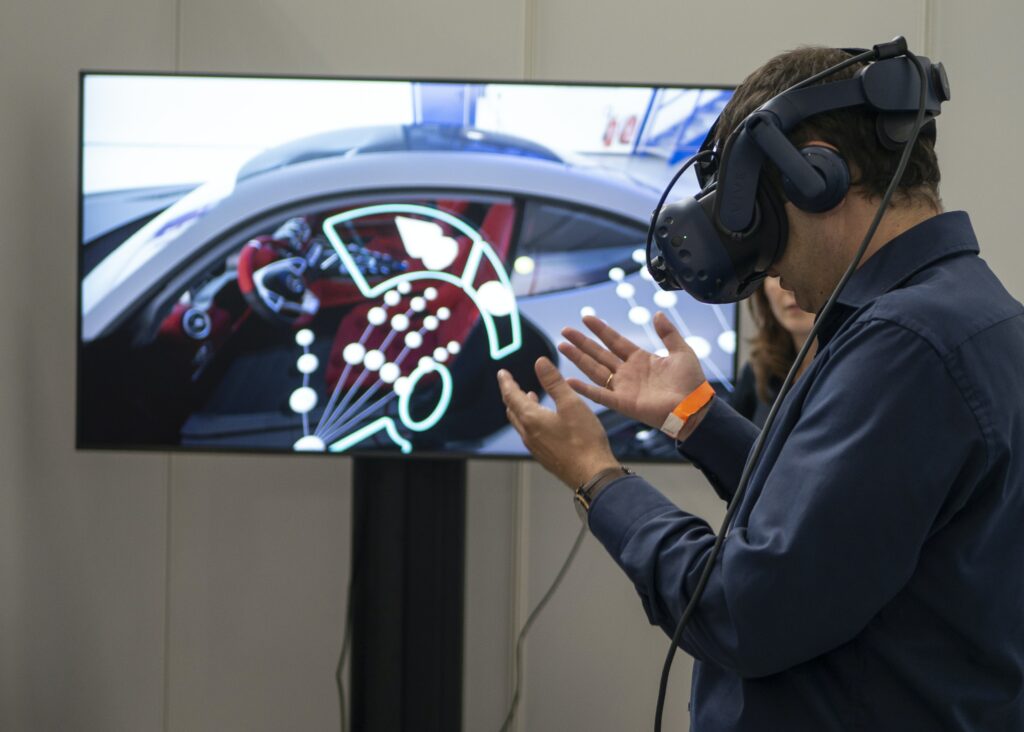Imagine a world where you can transform your living room into a battlefield, or go on a treasure hunt in your own backyard. With Augmented Reality Games, this exciting future is closer than you think. By seamlessly merging digital content with the real world, these games are revolutionizing the way we interact and engage with entertainment. Get ready to experience a whole new level of immersive gaming that blurs the line between fantasy and reality. Augmented Reality Games are here to redefine what it means to play.

The Evolution of Gaming
In recent years, the world of gaming has experienced a remarkable evolution. From traditional console and PC games to the advent of mobile gaming, and now the rise of virtual reality (VR) and augmented reality (AR) games, the industry has embraced technological advancements to provide users with more immersive and interactive experiences than ever before.
Traditional Console and PC Games
For many years, console and PC games were the dominant forms of gaming. Players would gather around the television or computer screen to enjoy hours of gameplay. These games offered highly detailed graphics, complex storylines, and a wide variety of genres to cater to different interests. While they still maintain a significant presence in the gaming industry today, the emergence of mobile gaming and AR technologies has introduced new possibilities for gaming enthusiasts.
Mobile Gaming
The rise of smartphones has revolutionized the gaming landscape. Mobile games have become increasingly popular, offering a convenient and accessible way for people to engage in gaming on the go. With millions of game apps available for download, mobile gaming has expanded beyond traditional gamers, attracting a diverse audience of casual players. This has created a competitive market for developers, pushing them to consistently innovate and deliver engaging experiences.
Virtual Reality Games
Virtual reality games have taken gaming to a whole new level. By immersing players in a simulated environment, VR allows for a truly immersive and immersive gaming experience. With the help of VR headsets and controllers, players can interact with virtual worlds, making them feel like they are part of the action. While VR games are still relatively new and limited in terms of accessibility, they have garnered significant attention and continue to evolve as the technology progresses.
Introduction to Augmented Reality Games
Augmented reality games have emerged as the latest frontier in the gaming industry. By overlaying digital elements onto the real world, AR games blend virtual and physical realities to create a unique and interactive gaming experience. With the widespread availability of smartphones and other wearable devices, AR games have the potential to reach a large audience and redefine the way we play and engage with games.
Understanding Augmented Reality
Before delving into the world of augmented reality games, it is important to understand the concept of augmented reality itself.
Definition of Augmented Reality
Augmented reality refers to the technology that combines virtual imagery with the real world. It enhances the real-world environment by overlaying digital information, such as graphics, sounds, and videos, onto it. This seamless integration of digital and physical elements creates an immersive and interactive experience for users.
Difference between Augmented Reality and Virtual Reality
While both augmented reality and virtual reality aim to provide immersive experiences, they differ in their approach. Virtual reality completely replaces the real world with a simulated virtual environment, while augmented reality enhances the real world by adding virtual elements to it. AR games utilize the existing physical surroundings to create a dynamic gaming experience, whereas VR games transport players to entirely virtual worlds.
Applications of Augmented Reality
Augmented reality has a wide range of applications beyond gaming. It has found its way into various sectors, including education, healthcare, architecture, and marketing. AR can be used to enhance learning experiences, aid in medical procedures, visualize architectural designs, and create interactive marketing campaigns. The versatility of AR technology opens up new possibilities for innovation and engagement across different industries.
The Rise of Augmented Reality Games
One game in particular played a significant role in introducing augmented reality games to the mainstream audience – Pokémon Go.
Pokémon Go: A Game-Changer
When Pokémon Go was released in 2016, it became a global phenomenon overnight. The game allowed players to capture virtual Pokémon creatures in the real world using their smartphones. This groundbreaking AR game utilized GPS and camera technologies to overlay Pokémon onto the player’s surroundings, making it seem as if the Pokémon were actually there. Pokémon Go brought augmented reality gaming into the mainstream and demonstrated the potential of AR to revolutionize the gaming industry.
Other Successful Augmented Reality Games
Following the success of Pokémon Go, other augmented reality games started gaining traction. Games like “Harry Potter: Wizards Unite” and “Minecraft Earth” further proved that AR can offer unique gaming experiences by merging the virtual and real worlds. These games allowed players to cast spells in the real world and build structures using virtual blocks, respectively. With each new AR game release, developers explore different genres and gameplay mechanics, pushing the boundaries of what is possible in augmented reality gaming.
Growing Popularity and User Engagement
Augmented reality games have gained immense popularity due to their ability to provide an interactive and engaging experience. The novelty of merging virtual elements with the real world has captivated players and created a sense of wonder and excitement. AR games encourage users to explore their surroundings, discover hidden treasures, and interact with virtual characters in ways that were previously unimaginable. As more people embrace augmented reality technology and its gaming potential, the demand for AR games continues to grow.
Advantages of Augmented Reality Games
Augmented reality games offer several advantages over traditional gaming experiences.
Real-world Interaction
One of the key advantages of AR games is the ability to interact with the real world while playing. Unlike traditional console or PC games, which often require players to sit in front of a screen, AR games encourage users to move around and explore their surroundings. This real-world interaction adds a new layer of immersion and excitement to gaming, as players actively participate in the game’s storyline and challenges.
Enhanced Immersion and Gameplay
AR games excel in providing an immersive gaming experience. By seamlessly integrating virtual elements into the real world, players feel as though they are a part of the game itself. Whether it’s battling virtual creatures on the streets or solving puzzles in familiar locations, AR games blur the line between fantasy and reality, enhancing the gameplay and making it more engaging.
Physical and Mental Exercise
Another advantage of AR games is their potential to promote physical activity and mental exercise. As players explore their surroundings, they are encouraged to walk, run, and even engage in more strenuous activities. This promotes a healthier lifestyle and helps combat the sedentary nature often associated with traditional gaming. Additionally, AR games often require problem-solving and strategic thinking, challenging players’ cognitive abilities and providing mental exercise.
Social and Collaborative Experiences
AR games have the unique ability to bring people together and foster social interactions. These games often encourage players to team up and collaborate in order to achieve common objectives. Whether it’s joining forces to defeat powerful virtual enemies or engaging in friendly competitions, AR games create opportunities for social bonding and cooperation. The shared experience of interacting with the same virtual elements in the real world also sparks discussions and builds communities among players.

Challenges Faced by Augmented Reality Games
While augmented reality games offer exciting possibilities, they also face several challenges that need to be addressed for widespread adoption and success.
Technical Constraints
One of the biggest challenges in developing AR games is the technical constraints. Augmented reality requires precise tracking of real-world objects and reliable integration of virtual elements. Achieving seamless augmentation in various environments, lighting conditions, and device specifications can be a complex process. Developers need to continually improve tracking algorithms and optimize performance to ensure a smooth and enjoyable gaming experience.
Safety and Privacy Concerns
As AR games merge virtual and physical realities, safety and privacy concerns come to the forefront. Players need to be wary of their surroundings while engrossed in the game to avoid accidents or potentially dangerous situations. Additionally, AR games often require access to a user’s personal data, such as location information, which raises concerns about privacy and data security. Developers must prioritize user safety and privacy by implementing measures to mitigate risks and protect personal information.
Integration with Real Environment
In order to provide a seamless gaming experience, AR games need to be well-integrated with the real environment. However, differing environmental conditions, architectural structures, and other real-world elements can pose challenges for game developers. Ensuring accurate alignment and interaction between virtual and physical elements in various settings is a complex task that requires continuous improvement and adaptation.
Limited Gaming Content
As a relatively new form of gaming, augmented reality still has limited content compared to traditional gaming platforms. The development of high-quality and diverse AR game content requires time and resources. However, as the popularity of AR games grows, more developers are venturing into this space, resulting in an increasing number of game releases. With continuous advancements in technology and increased demand, the availability of AR gaming content is expected to expand.
Technologies and Hardware for Augmented Reality Games
AR games rely on various technologies and hardware to deliver immersive experiences.
Smartphones and Tablets
The widespread availability of smartphones and tablets has fueled the growth of AR games. These devices are equipped with built-in cameras, GPS, and powerful processors, making them ideal for running AR applications. With the help of supporting software and frameworks, smartphones and tablets bring AR gaming to a wide audience, allowing users to enjoy augmented reality experiences without the need for additional hardware.
AR Glasses and Headsets
AR glasses and headsets offer a more immersive and hands-free experience compared to smartphones and tablets. These wearable devices overlay digital content directly onto the user’s field of view, enhancing the sense of realism and interaction. While AR glasses and headsets are still in the early stages of development, they hold great potential for the future of augmented reality gaming, offering a more seamless integration of virtual and physical realities.
Other Wearable Devices
In addition to AR glasses and headsets, there are other wearable devices that can enhance the AR gaming experience. Wearable controllers, such as motion-sensing gloves or haptic feedback vests, can provide more intuitive and tactile interactions with virtual elements. These devices add another layer of immersion and enhance gameplay mechanics in AR games, making them more engaging and lifelike.
Advancements in Sensor Technology
Sensor technology plays a vital role in the success of AR games. Accelerometers, gyroscopes, and depth sensors are used to accurately track the user’s movements and the orientation of the device. These sensors enable the seamless integration of virtual elements into the real world, allowing for precise interaction and alignment. As sensor technology continues to advance, AR games will benefit from enhanced tracking capabilities, resulting in more realistic and immersive experiences.

Gaming Genres in Augmented Reality
Augmented reality has opened up new possibilities for gaming across a wide range of genres.
Adventure and Exploration Games
Adventure and exploration games have become a popular genre in augmented reality. These games encourage players to go out into the real world and embark on virtual quests or treasure hunts. By overlaying virtual elements onto real-world locations, players can explore their surroundings in a whole new way, uncovering hidden secrets and engaging in thrilling adventures.
Simulation and Construction Games
Simulation and construction games have also found a place in the world of AR gaming. Players can build virtual structures or create virtual worlds within their real environment. This genre allows for hands-on creation, providing a sense of ownership and accomplishment as players see their virtual creations interact with the real world.
Strategy and Tactical Games
Strategy and tactical games in augmented reality provide a unique gameplay experience. Players can visualize battles and plan strategies by placing virtual units on real-world surfaces. This genre takes strategy games to a new level, as players must consider their real-world surroundings and make decisions based on the interaction between virtual and physical elements.
Sports and Fitness Games
Augmented reality has also made its mark in the realm of sports and fitness games. These games encourage physical activity by overlaying virtual sports elements onto real-world settings. Players can engage in virtual soccer matches or track and compete against their own fitness goals in the real world. This genre blurs the line between gaming and exercise, promoting a healthy and active lifestyle.
Educational and Learning Games
Augmented reality has immense potential in the field of education. Educational and learning games utilize AR to provide interactive and immersive learning experiences. By overlaying virtual objects, simulations, or animations onto educational materials, AR games engage students in a more dynamic and visual way, enhancing their understanding and retention of the subject matter.
Augmented Reality Game Development
Developing successful augmented reality games requires careful consideration of various factors.
Importance of Game Design
Game design plays a crucial role in the success of AR games. Designers must carefully analyze the real-world environment and seamlessly integrate virtual elements into it. This requires a deep understanding of the gaming mechanics, user experience, and the technical constraints of augmented reality. A well-designed AR game should provide a smooth and intuitive experience, capturing the attention and excitement of players.
Integration of Real-world Elements
To create a truly immersive AR experience, it is important to integrate real-world elements seamlessly with virtual elements. The boundary between the virtual and physical worlds should be blurred, making the virtual objects interact convincingly with real-world surroundings. Key considerations include accurate tracking, realistic lighting, and proper alignment of virtual objects with real objects.
Incorporating User Interaction and Feedback
AR games rely heavily on user interaction. The gameplay mechanics need to take full advantage of the unique features of augmented reality, such as gesture recognition, voice commands, and motion tracking. Developers should also incorporate feedback mechanisms to inform players of their progress, achievements, and any relevant real-world information. Effective user interaction and feedback enhance the overall gaming experience.
Implementing Artificial Intelligence
Artificial intelligence (AI) plays an important role in creating compelling AR gaming experiences. AI algorithms can be used to enhance the behavior and intelligence of virtual characters, making them more realistic and responsive to the player’s actions. Whether it’s NPCs (non-player characters) in adventure games or opponents in strategy games, AI can elevate the gaming experience by providing more challenging and dynamic gameplay.
Multiplayer Capabilities
Multiplayer capabilities are an integral part of many AR games. Multiplayer AR games allow players to interact and collaborate with each other in real time, creating a social and competitive experience. Implementing robust networking solutions is essential to ensure smooth communication between players, enabling them to engage in cooperative or competitive gameplay seamlessly.
Social and Ethical Impact of Augmented Reality Games
As with any technological advancement, augmented reality games have social and ethical implications that need to be addressed.
Increased Social Interaction
One of the positive impacts of AR games is the increased social interaction they promote. As players explore the real world together and engage in collaborative gameplay, they build connections and communities. AR games have the potential to bring people from different backgrounds and locations together, fostering a sense of belonging and camaraderie.
Impact on Physical Activity and Health
AR games have the potential to impact physical activity and health positively. By encouraging players to move and explore their surroundings, AR games promote physical activity and combat sedentary behavior. This can lead to improved fitness levels and overall health. However, it is important to strike a balance between gaming and physical activity to avoid potential health risks associated with excessive gameplay.
Safety and Behavioral Concerns
The integration of virtual and physical realities in AR games raises safety and behavioral concerns. Players need to be aware of their surroundings to avoid accidents or potential dangers while engrossed in the game. It is essential for developers to implement safety features and guidelines to minimize risks and ensure a safe gaming experience. Additionally, AR games can influence player behavior, and it is crucial to design games that promote responsible gaming habits and discourage harmful behaviors.
Issues of Addiction
As with any form of entertainment, addiction is a concern when it comes to augmented reality games. The immersive nature of AR games can make it easy for players to lose track of time and become overly consumed by the virtual world. Developers and users alike need to be mindful of the potential addictive nature of AR games and take measures to practice responsible gaming habits.
Effects on Real-world Environments
Augmented reality games have the potential to impact real-world environments. Players may inadvertently trespass on private property or disrupt public spaces while engrossed in the game. It is important for developers to incorporate mechanisms that encourage responsible gameplay and respect for the real world. Education and awareness campaigns can also help players understand their responsibilities and maintain a harmonious interaction with the physical environment.
Potential of Augmented Reality Games
The potential of augmented reality games goes beyond entertainment and gaming.
Entertainment Beyond Gaming
While gaming is the primary focus of augmented reality, the technology has the potential to revolutionize entertainment beyond gaming. AR can enhance storytelling experiences, allowing users to immerse themselves in interactive narratives or bring fictional characters to life. It can also enhance live events and performances by overlaying digital content onto real-world stages, creating a unique and immersive experience for the audience.
Education and Training Applications
The educational potential of augmented reality extends to various fields. AR can be used to create interactive learning experiences, providing students with visual and immersive content. It can also aid in training simulations, allowing professionals to practice in realistic virtual environments. The interactive and engaging nature of AR games has the potential to improve learning outcomes and enhance training effectiveness.
Augmented Reality in Cultural Heritage and Tourism
AR has the ability to bring cultural heritage and tourism to life. By overlaying virtual reconstructions or historical information onto real-world landmarks, AR can provide visitors with an enriched and immersive experience. AR can also assist in navigation and wayfinding, allowing tourists to explore new destinations with ease, enhancing their overall travel experience.
Business and Marketing Opportunities
Augmented reality presents numerous business and marketing opportunities. Brands can leverage AR to engage with their customers in novel and interactive ways. AR can be used for product visualization, allowing customers to experience products in their real environment before making a purchase. Additionally, AR advertising campaigns can captivate consumers and create memorable brand experiences, promoting brand loyalty and generating interest in products or services.
In conclusion, augmented reality games are the future of interactive entertainment. With their unique ability to blend virtual and physical realities, AR games provide immersive, engaging, and interactive experiences. Despite the challenges they face, such as technical constraints and safety concerns, the potential of AR games to revolutionize gaming and entertainment is undeniable. As technology continues to advance and more developers embrace this evolving medium, augmented reality games have the potential to shape the future of interactive entertainment in various industries.



